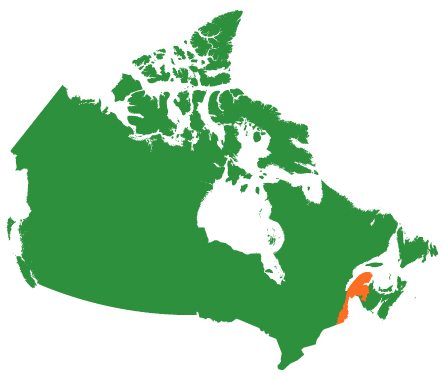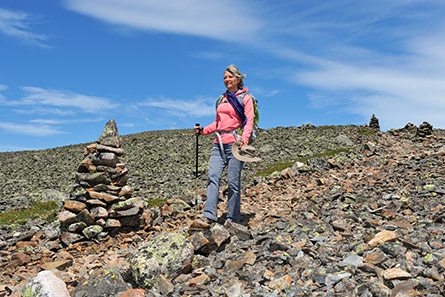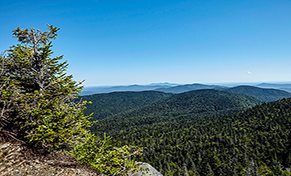GASPÉ & APPALACHIAN MOUNTAINS
Federal ecozones: Atlantic Highlands
Area: 91,045 km2
Natural cover: 84,522 km2
Per cent natural: 93%
Protected area: 4,407 km2
Per cent protected: 5%
Number of NCC projects (all): 165
Number of species of birds: 246
Number of species of trees: 66
Number of species of mammals: 78
Number of species of amphibians: 20
Estimated human population: 915,965

Description
The Gaspé and Appalachian Mountains are part of an ancient highland ecosystem that formed hundreds of millions of years ago through the merging of two tectonic plates. Extending from Georgia to New Brunswick and Gaspé, where the highlands meet the St. Lawrence River, this region is well-known for its diversity of habitats and species. Referred to as the “Gespeg” by the Mi’kmag, meaning “the place were the land ends,” the Gaspé Peninsula is the easternmost extension of the Appalachian Range into the Gulf of St. Lawrence. This region is characterized by steep coastal cliffs, rolling mountains and high-elevation tundra.
Gaspesie & Appalachian Mountains Landscape

Conservation Values
This region is one of the last large wilderness areas in southern Quebec and the Atlantic provinces. It is also one of the most intact temperate forests in eastern North America and is an important continental corridor for wildlife. Wide-ranging mammals include Canada lynx, black bear and American marten. It also one of the last refuges for the globaly rare Bicknell’s thrush. The Gulf of St. Lawrence coast is important habitat for seabirds and shorebirds, and the coastal marshes harbour several species that are endemic to the region.
Challenges/Threats
Given its close proximity to several cities, this region is a recreational hot spot for skiing, hiking, fishing and hunting. The Gaspé and Appalachian Mountains are coming under increasing pressure from resources development, recreational uses and new development, including development of second homes and roads.
What NCC is doing
NCC is working in a number of priority natural areas in this region, including:
- Corridor Forillon
- Gaspésie Coastal Habitats
- White Mountains
- Northern Green Mountains
- Trois-Frontières
NCC is working to protect large, intact habitats and maintain linkages for wildlife and to allow vegetation communities to shift as a result of climate change. In many places, this involves conserving lands around existing protected areas. NCC is working closely with partners in the U.S. to ensure that this mountain corridor is protected. NCC is also working closely to ensure that recreational activities do not impact the region’s biodiversity. Important coastal habitats, including salt marshes and beaches, have also been protected. Species at risk protected by NCC in this region include spring salamander, Bicknell’s thrush and Gulf of St. Lawrence aster.

Did you know?
- This region contains the most intact temperate forest in eastern North America.
- It serves as a major continental linkage for forests (initiatives include Two Countries, One Forest).
- The Gaspé region supports wide-ranging mammals and forest-dwelling wildlife, such as black bear, moose, Canada lynx, American marten and bobcat.
- It also supports one of the world’s southernmost populations of woodland caribou and the only population south of the St. Lawrence River.
- This region features the last intact lakes in southern Quebec.
- World-renowned Atlantic salmon populations occur on the Gaspé Peninsula.
Photo Credits (Top to bottom): All images iStock.


